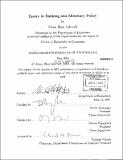Essays in banking and monetary policy
Author(s)
Ashcraft, Adam Blair, 1974-
DownloadFull printable version (11.07Mb)
Other Contributors
Massachusetts Institute of Technology. Dept. of Economics.
Advisor
Daron Acemoglu and Olivier Blanchard.
Terms of use
Metadata
Show full item recordAbstract
In the first chapter, I demonstrate that banks play a special role in the transmission mechanism of monetary policy, and that this role potentialy explains the excessive sensitivity and asymmetric response of the real economy to small and temporary changes in interest rates. While banks exploit imperfectly-priced deposit insurance in order to ameliorate the underinvestment problem created by financial constraints, open-market operations by the central bank control the aggregate supply of insured deposits, and thus the severity of these constraints. I demonstrate in the second chapter that tougher bank capital requirements did not affect on the banking industry in the 1980s. Banks with relatively low capital raised their capital ratios relative to better capitalized banks well before any tightening of standards, and did not change their behavior following the change in policy. This implies that banks have market-based incentives to hold capital, an important consideration in designing bank regulation. In the third chapter I illustrate that there is very little correlation between how monetary policy affects state output and how the shocks which monetary policy is trying to smooth affect state output. This correlation is weak enough to imply that while monetary policy may have reduced the variance of aggregate output growth over the last 30 years, it has actually increased volatility for a majority of states. This result has important implications in choosing appropriate target variables for the central bank.
Description
Thesis (Ph. D.)--Massachusetts Institute of Technology, Dept. of Economics, 2001. Includes bibliographical references (p. 167-178).
Date issued
2001Department
Massachusetts Institute of Technology. Department of EconomicsPublisher
Massachusetts Institute of Technology
Keywords
Economics.